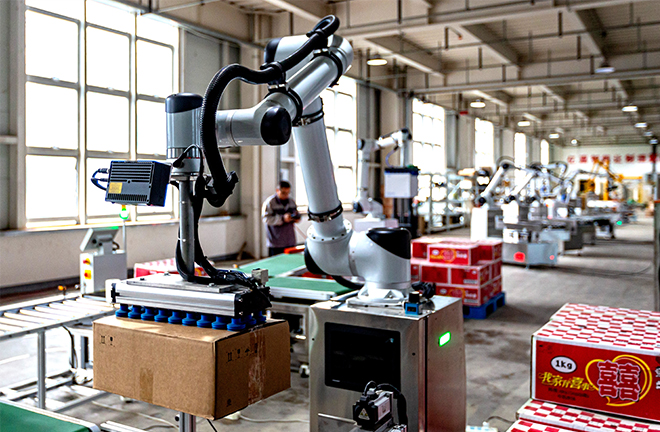Tax dividends from deployment of industrial robots

An industrial robot manufacturing company in Anyang, Henan Province Photo: IC PHOTO
Industrial robots, which have emerged during the latest wave of technological and industrial transformation, integrate artificial intelligence, information technology, and advanced manufacturing. They are driving a leap in productivity and profoundly transforming the modes of economic production, as their deployment not only boosts production automation but also affects capital structure and effective income tax rates at the corporate level.
Theoretical analysis
“Compensation tax deduction” effect: On one hand, industrial robots are expected to substantially replace repetitive labor, reducing companies’ demand for human workers and leading to lower wages. On the other hand, the cost savings and productivity gains from their use enable companies to scale up production, ultimately increasing labor demand and potentially raising wage levels. In addition, while the utilization of robots decreases the need for medium-skilled workers in routine tasks, it increases the need for high-skilled and low-skilled workers.
“Asset depreciation” effect: As a fixed asset investment for business operations, the acquisition of industrial robots increases capital expenditure, and in turn, increases depreciation deductions in corporate taxable income. Furthermore, companies that utilize industrial robots can postpone their tax liabilities through accelerated depreciation methods, thereby increasing the present value of their tax deductions. Therefore, the adoption of robots reduces corporate tax burdens.
“Debt tax shield” effect: The expenditure on industrial robots raises the level of interest-bearing corporate debt that is deductible before taxes. A large share of the industrial robots used by Chinese companies is imported, particularly the expensive high-end models. Due to limited internal funds, the purchase of these robots often relies on external financing such as loans. Under Chinese tax law, corporate interest expenses of this nature are eligible for pre-tax deduction.
Empirical evidence
This article utilizes the Bartik instrument to estimate the penetration of industrial robots at the corporate and municipal levels in China. It then empirically examines the impact of industrial robot adoption on corporate tax burdens and government tax revenue, using data from listed Chinese manufacturing companies and municipalities.
Micro-level studies reveal that the deployment of industrial robots significantly reduces corporate effective income tax rates through the “compensation tax deduction,” “asset depreciation,” and “debt tax shield” effects, generating a “tax burden reduction dividend” for companies—a conclusion that holds true across a series of robustness tests. At the corporate level, industrial robot utilization enhances production efficiency and allows for expanding production scale, thus increasing economic output and business performance. At the industry level, the use of industrial robots drives the development of the robotics industry and related sectors, stimulates new business models, augments profits in existing sectors while attracting new entrants, and invigorates market dynamics. Macro-level studies show that industrial robot adoption considerably increases government tax revenue through a broadened tax base, yielding a “tax revenue dividend” for the government.
In light of the discussion above, more precisely targeted structural tax policies are needed to facilitate the extensive development and adoption of new technologies and tools, while fostering the continuous emergence and vigorous growth of new companies and industries.
First, it is important to encourage companies to embrace emerging technologies. The government can set up dedicated funds to provide subsidies or low-interest loans to help firms overcome financial constraints when acquiring industrial robots. Second, targeted tax incentives should be put in place to enhance the coordination between tax policy and industrial policy. Third, the government should actively cultivate various emerging industries represented by the robotics industry. On one hand, policy tools such as tax, finance, and credit should be employed in an integrative fashion to support the application of robotics and other advanced technologies, boosting the supply of new products and the development of new industries in line with the demand for new means of production. On the other hand, it is necessary to direct more high-quality factors of production toward emerging industries in order to achieve a balance between tax and fee reduction, economic growth, and the sustainability of fiscal security.
Li Jianjun (professor) and Wu Zhouyi are from the School of Public Finance and Taxation at the Southwestern University of Finance and Economics.
Edited by WANG YOURAN
